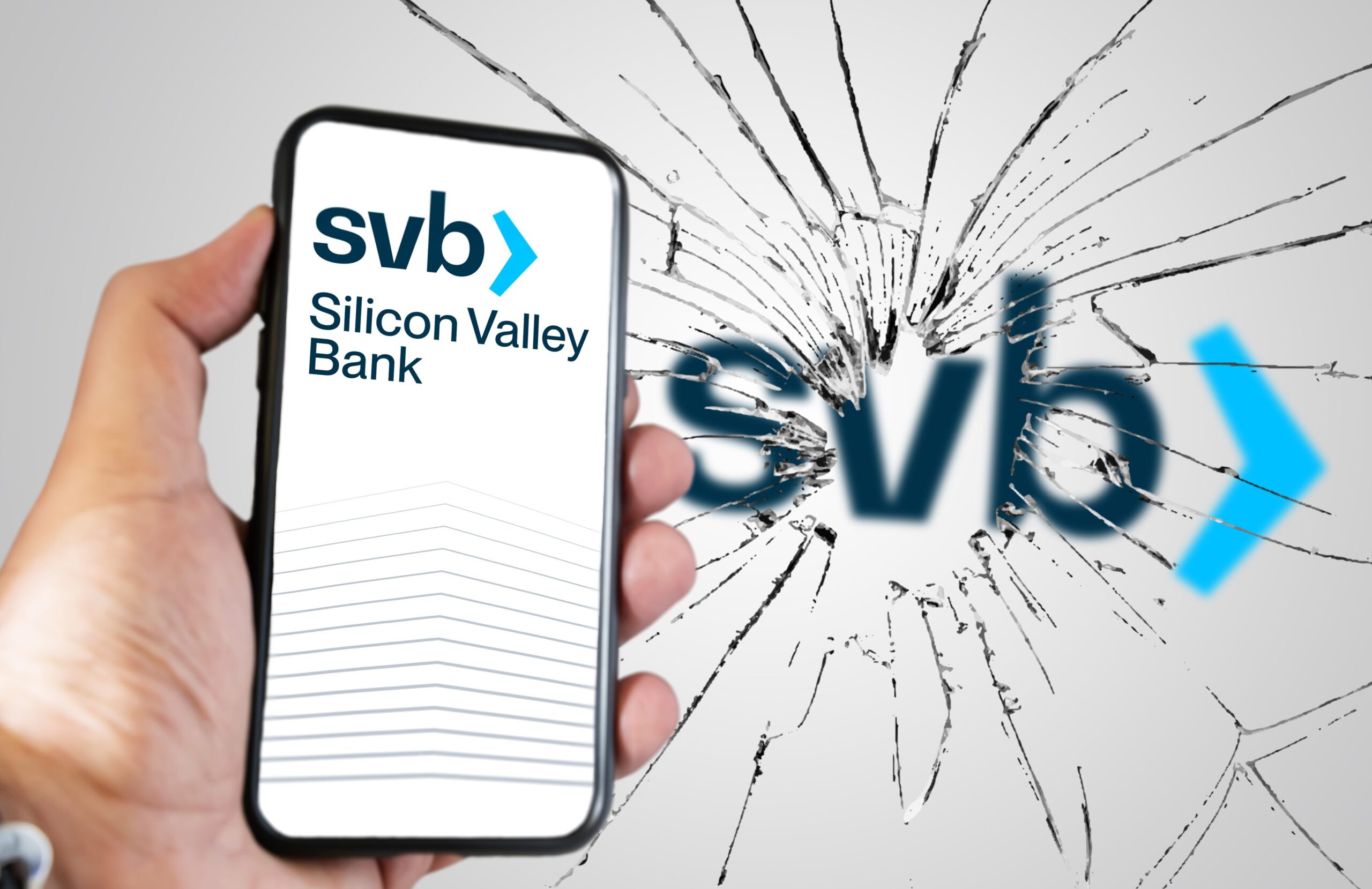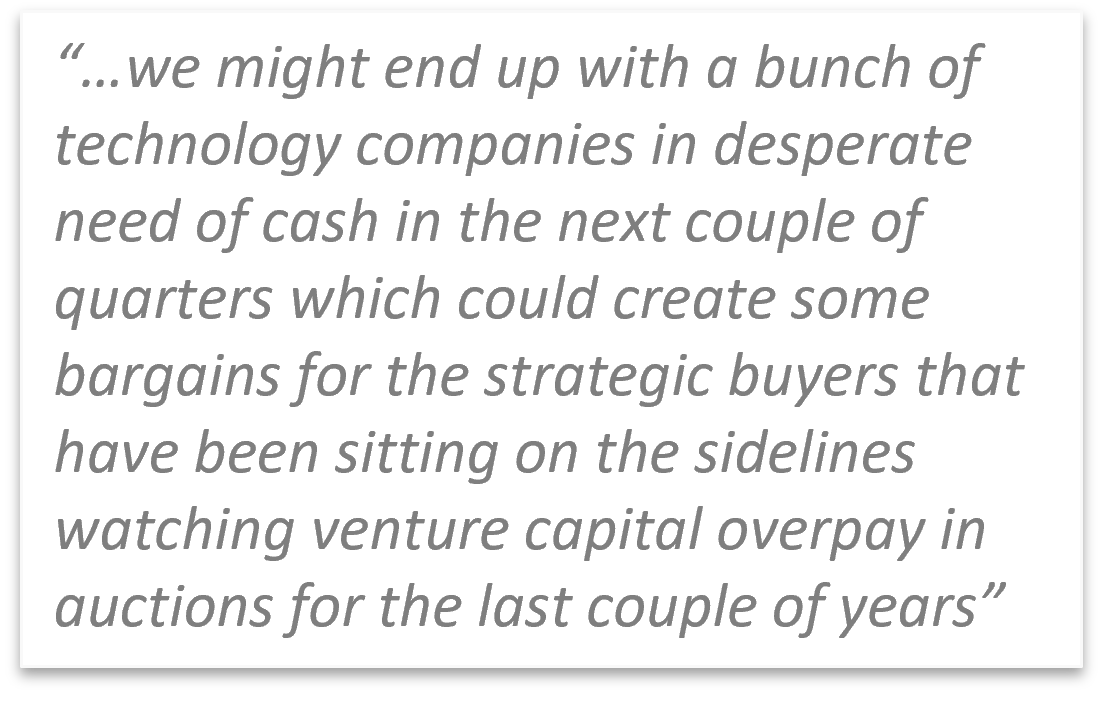
Bank Failures & Bailouts: What Does This All Mean For Middle-Market Mergers & Acquisitions?
I am not a big “place blame” person (unless you are my sister), so this blog won’t be about assigning blame, political wokeness, or Fed bashing. Rather, we are going to attempt to lay out what happened in plain language and what it means for middle-market merger and acquisitions.
Banking failures and banking bailouts. Is it causing you anxiety? Should it? And what does it mean if you are thinking about selling your business in the near future?
Silicon Valley Bank
Let’s take a look at Silicon Valley Bank (SVB). They were a bank that specialized in taking deposits from start ups — companies that generally don’t have any assets, can’t take out any loans, and don’t make any money. Why do start ups, technology, and biotech companies all end up at one bank? Finding a bank as a new company in any industry is difficult. Finding a bank as a new technology company, where you often don’t make money for years — is VERY difficult. SVB found a niche valuing and banking with businesses that had few assets. SVB also had allowed some founders to take mortgages and personal loans using equity in the technology company as the basis.
Then, as we hit a wave of economic slow down and inflation, these companies could no longer use an IPO as an exit and SVB started to give venture loans to companies that needed money in 2022, but didn’t have access to venture capital or the ability to go public.
Here’s a kicker that contributed to the problem (more about this later) — one key condition of the loans was that depositors keep 80% to 85% of their funds at SVB. This is not all that uncommon for banks.
All this meant that SVB didn’t look like an average well-diversified bank.
SVB had large deposits (after their clients raised funds from venture capital) and hadn’t historically made loans (usually where banks make money but their clients hadn’t needed money until recently) and so, in order to generate some capital, SVB bought long-term Treasury Bonds — which are super safe, but subject to interest rate risk. When the Feds raised interest rates, those Treasury Bonds held in the SVB portfolio were suddenly worth much less than before. SVB didn’t panic, they decided to raise some capital to fill in the value gap — very normal. However, their deposit holders did panic (“oh my gosh our bank is raising capital!”) and decided to withdraw funds. And if we learned anything from It’s A Wonderful Life, the cash isn’t sitting at the bank in the vault (do they even need vaults anymore?), it’s in other things…. not in Jake’s house and Mary’s store, but in this case, Treasury Bonds. It only took a few of these withdrawals for the FDIC to shut the bank down.
panic (“oh my gosh our bank is raising capital!”) and decided to withdraw funds. And if we learned anything from It’s A Wonderful Life, the cash isn’t sitting at the bank in the vault (do they even need vaults anymore?), it’s in other things…. not in Jake’s house and Mary’s store, but in this case, Treasury Bonds. It only took a few of these withdrawals for the FDIC to shut the bank down.
Later that week — Signature Bank — with strong exposure to Crypto currency had a similar mismatch and shut down.
The Regulatory Misstep
You might be wondering if we have regulators and rules in place that keep this kind of thing from happening. The answer is yes — yes we do. So, what happened here?
SVB was part of a lobbying group that engaged in an expensive campaign to raise the threshold for banks subject to risk checks known as “enhanced supervision” or stress tests that should have picked up on these kinds of concentrations of risk. This revision to the banking system passed in 2018 and raised the threshold for enhanced supervision from $50 billion in assets to $250 billion in assets.
“OK,” you say, “But, didn’t the executives of SVB understand the mismatch?’
Potentially. But, I’ll bet they were surprised by the speed with which the mismatch occurred and remember, they were ready to raise capital to bridge the gap. They were not necessarily concerned. The executives of SVB had recently grown their bank three-fold, increasing assets from $60 billion in 2020 to $200 billion at the time of collapse. Up to this point, they had been running a business that had been taking deposits from tech darlings valued at impossible multiples and paying them essentially 0% interest, investing it, and keeping all the profits. Maybe they had some hubris-induced overconfidence? Maybe they believed that interest rates would stay very low for a very long time?
The Bailout
As you may know, the FDIC insures deposits up to $250,000. For most people, that well exceeds what they have in a bank. For SVB and Signature Bank, they had some well-known depositors with amounts much larger than that. Interestingly, SVB had 94% of its deposits that were uninsured (meaning above the $250,000 level) and Signature Bank was 90% uninsured. Average large banks are about half this number.
Letting the $250,000 Federal deposit limit stand is one way this could have played out. After all, SVB was part of the group that lobbied for the lower supervision thresholds for community banks. Swooping in and insuring above the $250,000 limit could provide a moral hazard and actually increase the willingness of banks to engage in risky (read profitable) behaviors in the future if they know that the Government will ultimately step in and bail them out. In fact, when the concept of FDIC insurance was created, the risk of moral hazard was considered so great that many thought the whole idea was destined to create a banking system of risk takers. The initial limit of $100,000 was put in place to cover just enough to protect the depositors but not enough to create an incentive for banks to engage in risky behaviors.
Ultimately, the Treasury Department decided to use the FDIC Insurance Fund to fully protect all depositors at both SVB and Signature Bank, designating the banks as a “systemic risk.” By “systemic,” the Treasury Department meant that they did not want these failures to become a contagion to create other bank failures or, more specifically to put another nail in the coffin of the already damaged technology industry.
While it is easy to imagine “the technology industry” as an entire group of irreverent Elon Musk-like billionaires, the fact of the matter is that these are real, small businesses that employee real people and they have unique banking needs (which is why we have such a thing as Silicon Valley Bank in the first place). To leave the technology sector without a banking alternative, in the face of shriveling venture capital funds and increasing interest rates could have a significant impact on growth and productivity of the United States in the future.
What this bailout does do is give companies time to figure out where they should put their deposits. I can confirm that this is where venture capital and private equity portfolio companies are putting their efforts right now. So, as we wait for the Fed to decide between fighting inflation and creating more issues with regional banks, depositors have time to get into an insured situation. A very recent (it was updated March 13, 2023) paper, showed that U.S. bank asset exposure to a recent rise in interest rates is $2 trillion lower than is suggested by the book value of their assets and 10% of banks have larger unrecognized losses than SVB.
What Does This Mean For Middle-Market Mergers & Acquisitions?
A couple of forces are at work here. We don’t know what the Federal Reserve is ultimately going to decide to do with interest rates versus inflation in the next go around. We do know that there continues to be strong interest in middle-market M&A from all buyer groups — strategic and financial. We also have not seen a material drop in valuation multiples in any industry — even construction and consumer products in the middle-market have performed nicely. Technology, other than cybersecurity, has seen a more material valuation decrease from their highs, but is holding steady for now.
The Federal Reserve is a bit of a wildcard
For most businesses, an increase in interest rates is going to have the biggest effect on valuations — especially for transactions above $75 million (this number is somewhat arbitrary based on my experience in the marketplace). Above that amount, transactions are more reliant on bank debt to get done and are going to be more interest rate sensitive. Below that amount, they are generally less levered and have the possibility of being done with all equity. Obviously, there are exceptions to this rule and many buyers can write substantially larger equity checks, but the smaller transactions are having an easier go of it in this interest rate environment.
If you are a technology company…..
Hold onto your hats…..There are a lot of things going on here. Technology, biotech, and the start up world were already seeing an incredible shrinking of available venture capital dollars. If we now take away their ability to get a line of credit or a loan because no one wants to bank them for fear of becoming the next SVB, we might end up with a bunch of technology companies in desperate need of cash in the next couple of quarters, which could create some bargains for the strategic buyers that have been sitting on the sidelines watching venture capital overpay in auctions for the last couple of years. We could see valuations come down and strategic buyers become important players in auctions.
available venture capital dollars. If we now take away their ability to get a line of credit or a loan because no one wants to bank them for fear of becoming the next SVB, we might end up with a bunch of technology companies in desperate need of cash in the next couple of quarters, which could create some bargains for the strategic buyers that have been sitting on the sidelines watching venture capital overpay in auctions for the last couple of years. We could see valuations come down and strategic buyers become important players in auctions.
Back to our initial question. These most recent bank failures are exposing some weaknesses in our system. If you not a technology company and you are thinking of selling and you are in the lower-middle-market, chances are you will not be impacted at all. If you are a technology company, you might find you are looking at different valuation multiples and a challenging financing environment for the next couple of quarters. If you are in a large corporate development position you might want to begin looking at smaller acquisition targets because there will be a vacuum created as VC firms demonstrate their tendency to pull back in the face of market upheaval.